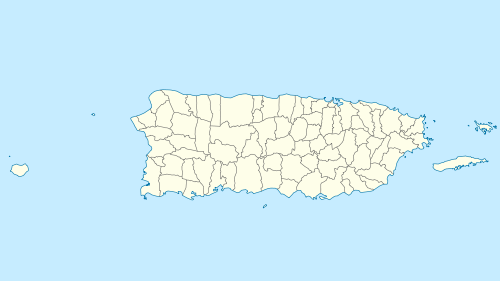Caparra Archaeological Site
|
Caparra | |
|
Ruins of Juan Ponce de Leon's residence at Caparra | |
 | |
| Location | Guaynabo, Puerto Rico |
|---|---|
| Area | 3 acres (1.2 ha) |
| NRHP Reference # | [2] |
| Significant dates | |
| Added to NRHP | February 28, 1984[2] |
| Designated NHL | April 19, 1994[1] |
Caparra is an archaeological site in the municipality of Guaynabo, Puerto Rico. It was declared a U.S. National Historic Landmark in 1994. The site contains the remains of the first Spanish capital of the island, settled in 1508 and abandoned in 1521. It represents the oldest known European settlements on United States territory.[1]
The site is on the grounds of the Museum of the Conquest and Colonization of Puerto Rico (Museo de la Conquista y Colonizaciòn), which features artifacts from the site and other archaeological sites in Puerto Rico.
History
In 1508, Juan Ponce de León founded the original Spanish settlement in Puerto Rico at Caparra (named after the province of Cáceres, Spain, the birthplace of then-governor of Spain's Caribbean territories Nicolás de Ovando),[3] which today is known as the Pueblo Viejo sector of Guaynabo, just to the west of the present San Juan metropolitan area. But the air was not wholesome and the mendicant friars insisted on moving the settlement closer to the bay and to the sea. They complained that the infants were dying. Their preferred area was that of the Islet of Puerto Rico ("rich port" or "good port"), because of its similar geographical features to the island of Gran Canaria in the Canary Islands. It was not until the end of Ponce de León's tenure as governor that they had their wish. By 1521, the move was complete and it was known as "Villa de Puerto Rico." With time the name of the island, San Juan Bautista de Puerto Rico, traded places with what is now the capial of Puerto Rico: John the Baptist.[4]
Archaeological history
The Caparra Site was first identified as important during a survey in 1936, as part of a program to develop tourist facilities on the island. Preliminary excavations in 1936 and 1937 identified a large tapia structure, bisected by a two-lane highway, that matched de León's description of his own residence, the only non-wooden structure in the settlement. Further excavation identified the main plaza and the sites of other buildings. The property was acquired by the Puerto Rican government in 1948, which relocated the northern section of the house ruins in order to widen the road. The roadway was again widened in 1963, destroying the southern portion of the structure excavated in 1936. The museum was established in 1958; the site continues to be examined by archaeologists.[5]
See also
- List of United States National Historic Landmarks in United States commonwealths and territories, associated states, and foreign states
- National Register of Historic Places listings in metropolitan San Juan, Puerto Rico
References
- 1 2 3 "Caparra". National Historic Landmark summary listing. National Park Service. Archived from the original on 2008-07-01. Retrieved 2008-06-23.
- 1 2 National Park Service (2010-07-09). "National Register Information System". National Register of Historic Places. National Park Service.
- ↑ "Guaynabo -- Encyclopædia Britannica" (with history of Puerto Rico),Encyclopædia Britannica, 2006, Britannica.com webpage:EB-Guaynabo-Puerto-Rico:names: Caparra, the first Spanish settlement in Puerto Rico (1508).
- ↑ de Quiro s., M.B. (1864–1884). "(oleccio n de documentos inéditos relativos al descubrimiento, conquista y organización de las antiguas posesiones españolas de Ame rica y Ocean a ... Madrid: M.B. de Quiro s.". pp. 463–79. Retrieved December 12, 2015.
- ↑ "NHL nomination for Caparra Site" (PDF). National Park Service. Retrieved 2015-11-04.
External links
- Museo y Parque Histórico Ruinas de Caparra - Institute of Puerto Rican Culture
- Caparra Ruins - information
- Information from the National Park Service
Coordinates: 18°24′18″N 66°06′51″W / 18.40500°N 66.11417°W